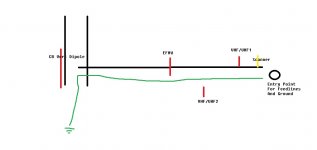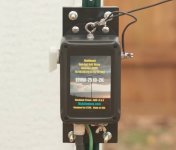- Joined
- Aug 19, 2014
- Messages
- 109
so i'm planning to put up 3 new antennas on my roof to go with the existing dual band and scanner.... lots of planning, getting up there requires scaffolding, i have to get it all done and tested in a day....
in a space around 30ft long and 20ft wide, i'll be putting the EFHW in the center of the roof on a roof peak mount, the CB antenna will be on the south end of the roof on the chimney, and the dual band antenna will be attached to a vent pipe about 10ft from the EFHW and lower on the roof.
my current dual band and my scanner antenna will be on the north end of the roof, roughly 15ft from the EFHW and the new dual band... but - all the coax comes in through a service cap on the north end of the roof.
i plan to run a ground wire the entire length of the roof and in with the feedlines. the ground rod will have to be at the south end of the house, it cannot be at the north end where the feedlines come in. but, this will allow me a common ground point for all the feedlines and the equipment inside.
when i looked online at EFHW installs, i saw a video where someone had a great low-noise antenna that ran a counterpoise/ground wire straight to ground
(check out the 2min mark or the attached pic where the ground/counterpoise is shown).
>> my questions <<
i plan on having all these antennas feed in and then putting in MFJ lightning protectors that connect to a shared ground bar that will then connect to the #4 stranded copper ground cable going across the entire roof, then to the ground rod. this way all antennas can bleed off any static from wind and RFI in the coax shield, and hopefully deal with any lightning.
would it be better to run grounds directly from the antenna to the exposed ground cable running the length of the roof, attaching at different points, or is it better to have them combine at a ground bar?
AND - given that the ground/counterpoise point on the EFHW are the same, will having the others attached make the other antennas part of the EFHW counterpoise?
thanks,
Richard
N0TZC
in a space around 30ft long and 20ft wide, i'll be putting the EFHW in the center of the roof on a roof peak mount, the CB antenna will be on the south end of the roof on the chimney, and the dual band antenna will be attached to a vent pipe about 10ft from the EFHW and lower on the roof.
my current dual band and my scanner antenna will be on the north end of the roof, roughly 15ft from the EFHW and the new dual band... but - all the coax comes in through a service cap on the north end of the roof.
i plan to run a ground wire the entire length of the roof and in with the feedlines. the ground rod will have to be at the south end of the house, it cannot be at the north end where the feedlines come in. but, this will allow me a common ground point for all the feedlines and the equipment inside.
when i looked online at EFHW installs, i saw a video where someone had a great low-noise antenna that ran a counterpoise/ground wire straight to ground
(check out the 2min mark or the attached pic where the ground/counterpoise is shown).
>> my questions <<
i plan on having all these antennas feed in and then putting in MFJ lightning protectors that connect to a shared ground bar that will then connect to the #4 stranded copper ground cable going across the entire roof, then to the ground rod. this way all antennas can bleed off any static from wind and RFI in the coax shield, and hopefully deal with any lightning.
would it be better to run grounds directly from the antenna to the exposed ground cable running the length of the roof, attaching at different points, or is it better to have them combine at a ground bar?
AND - given that the ground/counterpoise point on the EFHW are the same, will having the others attached make the other antennas part of the EFHW counterpoise?
thanks,
Richard
N0TZC



